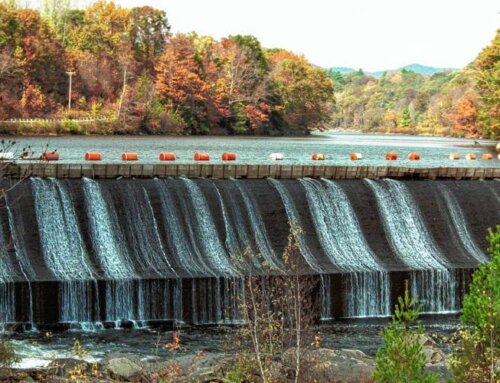Elizabeth Farnsworth has paddled all 410 miles of the Connecticut River in a kayak she made herself and co-authored a new guide to help others enjoy the voyage.
‘It’s such a liberating feeling to be out there,’ she said. ‘There’s something about being on the water and feeling the ebbing and flowing, surrounded by birds and fish and the exuberance of living things. It’s restorative in a way that sitting in front of a computer is not.’
Farnsworth, 44, lives in Royalston, a half-mile from the New Hampshire border, but lived in the Pioneer Valley for 12 years. She has taught environmental studies at Smith and conservation biology at Hampshire.
Farnsworth researched and wrote ‘The Connecticut River Boating Guide’ with fellow kayakers John and Wendy Sinton, a retired couple who live in Florence.
Together, they have devoted much attention to the river that runs through Hampshire County, starting at its source near the Canadian border and documenting its twists and turns and flora and fauna all the way to the sea.
‘Whenever I go onto a river, I become part of the flow of history and nature,’ said John Sinton. ‘It’s a nice corrective to that false hope that everything will remain the same, a counterpoint to the way I live most of my life.’
The guide divides the river into 23 ‘reaches,’ between 7 and 23 miles long, which can be paddled in one day. The authors used hand-held global-positioning technology to create precise maps and mileage points to all major features on the river.
For each section, the authors provide practical information on access points, boat types, parking, toilets, camping, rentals and supplies. The guide describes areas that are difficult to navigate and outlines local fishing regulations.
It is highly specific. At the site of dinosaur prints near Holyoke, it reads, ‘In high water a famous standing wave, called Wave-O-Saurus, occurs here and draws whitewater kayakers from around the region.’
The guide cautions that, near Northampton, the river has been the site of several accidents ‘because of the large number of craft and careless boat handling, especially when boaters are under the influence of alcohol.’
The guide has sections on the river’s geology, plants, fish, animals and history. ‘Yes, you see moose and bald eagles up close and personal,’ said Farnsworth. Paddlers can also see bears, otters, weasels, ospreys and two dozen species of warblers.
As old as it is longThe Connecticut River is old and long. It’s about 200 million years old,
and its halfway point is near White River Junction, Vt., she said.
Farnsworth made her kayak from scratch, using cedar with mahogany trim, and named it ‘Canu,’ which means ‘to sing’ in Gaelic. She is also a musician, and her day job is as a scientific illustrator with the New England Wildflower Society.
The river was an important gathering place for native tribes, providing food and transportation, she said. It was one of the first places colonized by white people, became important for agriculture and shipping, and was an industrial magnet and tourist attraction in the 1800s.
In the first part of the 20th century, much of the Connecticut became polluted, but it has become much cleaner over the last 50 years. ‘It’s a miracle,’ Farnsworth said.
The guide is published in cooperation with the Connecticut River Watershed Council, a watchdog group in which John Sinton is active. He described his work on the guide as ‘one of the great retirement gigs of all time.’
Sinton, who was a professor of geography and regional planning, wrote the majority of the short essays in the guide on such topics as log drives, land trusts, dams, floods, the 1704 Deerfield raid and boatbuilding. His wife, Wendy, a retired family therapist, is a South Hadley native.
‘We wanted to invite people into the river rather than just guide them on it,’ he said.
And anyone who’s in reasonable shape can paddle the entire river in a kayak in about a month, he said. The best times to do it are in May and June, when the water level is high.
Kayakers who take along the guide will be happy to hear that it has a waterproof binding that’s guaranteed by its publisher, Globe Pequot Press of Guilford, Conn. It updates a guide that was first published in 1986.
The guide manages to convey the authors’ enthusiasm for the experience as well as the exact location of access points.
‘I’m drawn to the rhythms of the river,’ Farnsworth said. ‘There’s a real living beast out there.’
The book is available for $19.95 at local stores and at ctriver.org.







